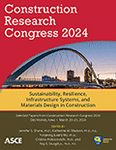A Life-Cycle Analysis-Based Framework to Analyze Various Circular Economy Strategies in Buildings
Publication: Construction Research Congress 2024
ABSTRACT
A shift to the circular economy is inevitable in the construction sector for sustainable development, as it promises solutions to two main problems of the industry—dealing with the waste generated and overcoming the shortage of raw materials. This study tries to identify circular practices in the construction industry, constraints to their wide acceptance, and recommendations to promote them. At the end-of-life of a building when it is demolished, a large amount of waste is generated, and its handling is a major problem. In this study, life-cycle analysis methodology is adopted to analyze various scenarios after useful life of a model building. The environmental impacts are calculated in terms of carbon emissions, taking into account two life cycles of building, considering options of deconstruction and demolition. Total carbon emissions are calculated for different scenarios, and the results show a significant reduction in the impacts for circular strategies.
Get full access to this article
View all available purchase options and get full access to this chapter.
REFERENCES
Bansal, D., Kamat, M., Ralegaonkar, R., and Bansal, Y. (2022). “Environmental impact assessment of demolition of a building in India-A case study.” Proc.,Ann Civil Environ. Eng., 042–049.
Cheela, V. R. S., John, M., Biswas, W. K., and Dubey, B. (2021). “Environmental impact evaluation of current municipal solid waste treatments in India using life cycle assessment.” Energies, 14(11), 31–33.
Danthurebandara, M., Van Passel, S., Nelen, D., Tielemans, Y., and Van Acker, K. (2012). “Environmental and socio-economic impacts of landfills.” Linnaeus Eco-Tech, 40–52.
Eštoková, A., Wolfová Fabiánová, M., and Ondová, M. (2022). “Concrete structures and their impacts on climate change and water and raw material resource depletion.” International Journal of Civil Engineering, 20(6), 735–747.
Gaur, J., Mani, V., Banerjee, P., Amini, M., and Gupta, R. (2019). “Towards building circular economy: a cross-cultural study of consumers’ purchase intentions for reconstructed products.” Management Decision, 57(4), 886–903.
Han, Y., Zheng, H., Huang, Y., and Li, X. (2022). “Considering consumers’ green preferences and government subsidies in the decision making of the construction and demolition waste recycling supply chain: a Stackelberg game approach.” Buildings, 12(6), 832.
Huovila, P., and Westerholm, N. (2022). “Circularity and sustainability in the construction value chain.” IOP Conference Series: Earth and Environmental Science, 1078(1), 012004.
IFC Database. (2017). “India construction materials database of embodied energy and global warming potential.”.
Joachim, O. I., Kamarudin, N., Aliagha, G. U., and Ufere, K. J. (2015). “Theoretical explanations of environmental motivations and expectations of clients on green building demand and investment.” IOP Conference Series: Earth and Environmental Science, 23(1), 012010).
Llatas, C., Bizcocho, N., Soust-Verdaguer, B., Montes, M. V., and Quiñones, R. (2021). “An LCA-based model for assessing prevention versus non-prevention of construction waste in buildings.” Waste Management, 126, 608–622.
Mah, C. M., Fujiwara, T., and Ho, C. S. (2017). “Concrete waste management decision analysis based on life cycle assessment.” Chemical Engineering Transactions, 56, 25–30.
Mhatre, P., Gedam, V. V., and Unnikrishnan, S. (2021). “Material circularity potential for construction materials–The case of transportation infrastructure in India.” Resources Policy, 74, 102446.
Norouzi, M., Chàfer, M., Cabeza, L. F., Jiménez, L., and Boer, D. (2021). “Circular economy in the building and construction sector: A scientific evolution analysis.” Journal of Building Engineering, 44, 102704.
Praseeda, K. I., Reddy, B. V., and Mani, M. (2016). “Embodied and operational energy of urban residential buildings in India.” Energy and buildings, 110, 211–219.
Roberts, M., Allen, S., and Coley, D. (2020). “Life cycle assessment in the building design process–A systematic literature review.” Building and Environment, 185, 107274.
Salas, D. A., Criollo, P., and Ramirez, A. D. (2021). “The role of higher education institutions in the implementation of circular economy in Latin America.” Sustainability, 13(17), 9805.
Sharma, B. K., and Chandel, M. K. (2017). “Life cycle assessment of potential municipal solid waste management strategies for Mumbai, India.” Waste Management and Research, 35(1), 79–91.
Shooshtarian, S., Caldera, S., Maqsood, T., and Ryley, T. (2020). “Using recycled construction and demolition waste products: A review of stakeholders’ perceptions, decisions, and motivations.” Recycling, 5(4), 31.
Singh, N., Mishra, T., and Banerjee, R. (2022). “Emission inventory for road transport in India in 2020: framework and post facto policy impact assessment.” Environmental Science and Pollution Research, 29(14), 20844–20863.
van Stijn, A., Eberhardt, L. M., Jansen, B. W., and Meijer, A. (2021). “A circular economy life cycle assessment (CE-LCA) model for building components.” Resources, Conservation and Recycling, 174, 105683.
Zhang, N., Gruhler, K., and Schiller, G. (2023). “A review of spatial characteristics influencing circular economy in the built environment.” Environmental Science and Pollution Research, 1–23.
Information & Authors
Information
Published In
History
Published online: Mar 18, 2024
Authors
Metrics & Citations
Metrics
Citations
Download citation
If you have the appropriate software installed, you can download article citation data to the citation manager of your choice. Simply select your manager software from the list below and click Download.
